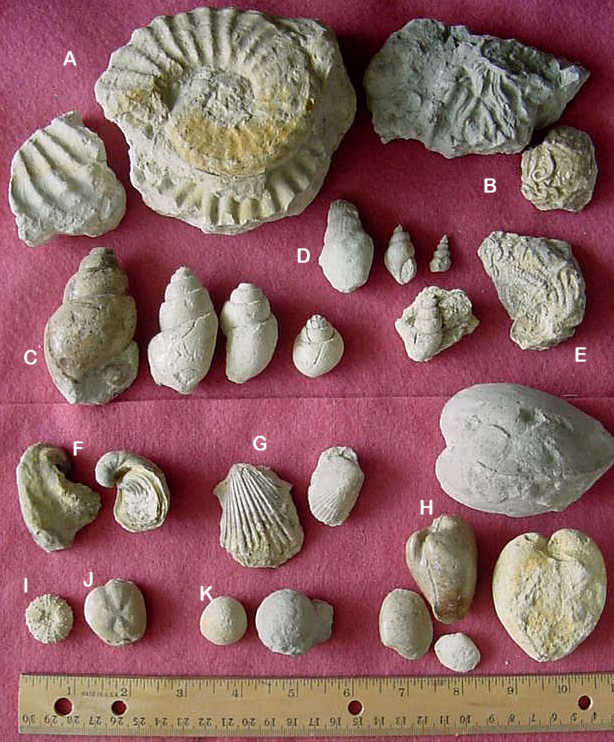Common Fossils in the Glen Rose Limestone
Compiled by Glen Kuban
 The Glen Rose Limestone formation is part of the Trinity Group of
Lower Cretaceous Rocks. The famous beds containing dinosaur tracks
in the Glen Rose, Texas area are near the base of the Glen Rose
formation, at or near the Aptian/Albian boundary, dated at approximately
110 million years. The Glen Rose formation was deposited during
the periodic retreat and advancement of a large shallow
sea, which may be considered the ancient gulf of Mexico. The
deposits represent low subtidal to supratidal environments and
typically exhibits alternating beds of hard limestone and softer
marl (limy clays and shales).
The Glen Rose Limestone formation is part of the Trinity Group of
Lower Cretaceous Rocks. The famous beds containing dinosaur tracks
in the Glen Rose, Texas area are near the base of the Glen Rose
formation, at or near the Aptian/Albian boundary, dated at approximately
110 million years. The Glen Rose formation was deposited during
the periodic retreat and advancement of a large shallow
sea, which may be considered the ancient gulf of Mexico. The
deposits represent low subtidal to supratidal environments and
typically exhibits alternating beds of hard limestone and softer
marl (limy clays and shales).
Some common types of fossils in the Glen Rose formation include
A. Ammonites (coiled-shelled animals related to squid), B.
serpulid worm tubes, snail steinkerns (internal molds)
such as C. Tylostoma and D. Anchura, bivalves
such as F. the oyster
Texigryphea, G. the scallop Neithea (left),
and the clam Lima waconensis (right), H. Various clam steinkerns, often called
"deer hearts" by locals; I. regular (round) urchins,
J. heart urchins, and K. Porocystis, which looks like a ball with
many small pores and a larger opening at one end. It has often
been mistaken for a sponge, but is actually an algal fruiting body.
No official permission is given to collect at road cuts in
the Glen Rose area, but here is a
map showing some outcrops
where fossils have been collected in the past. Be sure
to check different areas and levels of a roadcut. Sometimes the
fossils are very unevenly distributed.
For more information on Texas fossils see
Field Guide to Fossils of Texas
by Charles Finsley, Gulf Publishing Co., Houston, TX, 1996,
or any of the Texas Paleontology Series of fossil guide books
from the Houston Gem and Mineral Society.
For more information on the stratigraphy and geology of the
Glen Rose formation, see the North-Texas stratrigraphy page
at
www.cretaceousfossils.com
 The Glen Rose Limestone formation is part of the Trinity Group of
Lower Cretaceous Rocks. The famous beds containing dinosaur tracks
in the Glen Rose, Texas area are near the base of the Glen Rose
formation, at or near the Aptian/Albian boundary, dated at approximately
110 million years. The Glen Rose formation was deposited during
the periodic retreat and advancement of a large shallow
sea, which may be considered the ancient gulf of Mexico. The
deposits represent low subtidal to supratidal environments and
typically exhibits alternating beds of hard limestone and softer
marl (limy clays and shales).
The Glen Rose Limestone formation is part of the Trinity Group of
Lower Cretaceous Rocks. The famous beds containing dinosaur tracks
in the Glen Rose, Texas area are near the base of the Glen Rose
formation, at or near the Aptian/Albian boundary, dated at approximately
110 million years. The Glen Rose formation was deposited during
the periodic retreat and advancement of a large shallow
sea, which may be considered the ancient gulf of Mexico. The
deposits represent low subtidal to supratidal environments and
typically exhibits alternating beds of hard limestone and softer
marl (limy clays and shales).